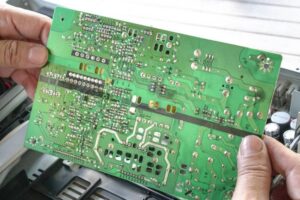How to Meet Standards for EMI and EMC for PCB Design?
2022-11-23
Electromagnetic interference (EMI) is closely related to our lives. For example, when you use a wireless network, while using a microwave oven, you will feel some influence of radio signals; in the airplane was asked to turn off electronic devices and other situations.
Due to the huge number of electronic products, the impact of EMI must be taken into account.
What is EMI and EMC in PCB?
EMC is the ability of an electronic system to operate in an electromagnetic environment without generating EMI or electromagnetic interference.
EMI is electromagnetic interference or disturbance, which disrupts signal quality and causes equipment to malfunction when energy is transmitted from one electronic device to another.
What is EMC/EMI standards in PCB design?
The goal of EMC/EMI standards is to maintain compatibility between electrical and electronic systems in the same location for trouble-free operation.
Two types of requirements of EMC/EMI: regulatory standards and industry standards.
EMC regulatory standards vary from region to region. Early EMC standards were developed by the US Federal Communications Commission. The European Community later developed its own EMC standards, known today as the EMC Directive.
Industry standards, on the other hand, are defined by industry and can ensure operability and uniformity.
Broad requirements for compliance with EMC standards
Electronic circuits consist of multiple electronic components arranged in a predetermined manner. If not arranged properly, they can lead to various EMI/EMC problems. In order to comply with EMC standards, designs need to meet the following aspects.
- EMI immunity design. Attention to proper stacking and wiring strategies.
- Equipment radiation control. Need to ensure that the equipment emits the least amount of radiation, for PCB stacking, component placement, grounding design strategies, etc. to optimize.
- Suppress conducted EMI. conducted EMI can take many forms, such as switching noise from SMPS regulators, coupled common-mode noise, etc.
- Pay attention to transients or power fluctuations. This may be in the form of buck, power spikes, etc.
- Surge and ESD design.
What does EMC testing consist of?
EMC test includes EMI and EMS two parts, EMI test content is mainly the following items
- Radiated Emission
- Conducted Emission
- Harmonic
- Flicker
Effective strategies to help pass EMC standard tests
Lamination, Power and Grounding
PCB designs use low inductance grounding systems to minimize EMI. multilayer PCBs place ground layers below signal layers to minimize loop inductance.
Shielding
The simplest method is to use ground shielding to form a Faraday cage around sensitive components and alignments. Some common types used to always radiate EMI are
- Shielding cans
- Conductive foam
- Wire mesh material
- Metal tape
- Conformal coating
Differential pairs
Use differential protocols to route signals whenever possible. Compared to ordinary single-ended signal routing, differential signals have the advantages of high interference immunity, effective EMI suppression, and precise timing positioning.
Mixed-signal and layout routing
It can be a good separation of the digital, low frequency analog and RF analog parts of the board.
Decoupling capacitors
It is recommended to use bypass/decoupling capacitors between the power supply pins of active components and the ground cross-hole. This ensures that residual noise is passed to ground.
To summarize
The EMC bucket of any electronic circuit is related to the generation, propagation and reception of electromagnetic noise. It is important to use the right tools and the right expertise to design PCBs so that they comply with EMI/EMC standards. The right PCB assembly partner can create compliant layouts and also perform any rework.
If you have any requirements or urgent help with PCB fabrication, kindly send your inquiry by sales@kingpcb.com or contact us through our contact page.



